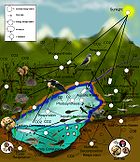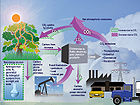- Community (ecology)
-
"Ecological community" redirects here. For human community organized around economic and ecological sustainability, see ecovillage.
 Interspecific interactions such as predation are a key aspect of community ecology.[citation needed]
Interspecific interactions such as predation are a key aspect of community ecology.[citation needed]
In ecology, a community is an assemblage of two or more populations of different species occupying the same geographical area. The term community has a variety of uses. In its simplest form it refers to groups of organisms in a specific place and/or time, for example, "the fish community of Lake Ontario before industrialization".
Community ecologists study the interactions between species in communities on many spatial and temporal scales, including the distribution, structure, abundance, demography, and interactions between coexisting populations.[1] The primary focus of community ecology is on the interactions between populations as determined by specific genotypic and phenotypic characteristics. Community ecology has its origin in European plant sociology. Modern community ecology examines patterns such as variation in species richness, equitability, productivity and food web structure (see community structure); it also examines processes such as predator-prey population dynamics, succession, and community assembly.
On a deeper level the meaning and value of the community concept in ecology is up for debate. Communities have traditionally been understood on a fine scale in terms of local processes constructing (or destructing) an assemblage of species, such as the way climate change is likely to affect the make-up of grass communities.[2] Recently this local community focus has been criticised. Robert Ricklefs has argued that it's more useful to think of communities on a regional scale, drawing on evolutionary taxonomy and biogeography,[1] where some species or clades evolve and others go extinct.[3]
Contents
Interspecific interactions
Species interact in various ways: competition, predation, parasitism, mutualism, commensalism, etc. The organization of a biological community with respect to ecological interactions is referred to as community structure.
Competition
Species can compete with each other for finite resources. It is considered to be an important limiting factor of population size, biomass and species richness. Many types of competition have been described, but proving the existence of these interactions is a matter of debate. Direct competition has been observed between individuals, populations and species, but there is little evidence that competition has been the driving force in the evolution of large groups. For example, between amphibians, reptiles and mammals.[4]
- Interference competition: occurs when one population attacks, or consumes the resources, of another. Examples include a lion chasing a hyena from a kill, or a plant releasing allelopathic chemicals to impede the growth of a competing species.
- Exploitative competition: occurs via the consumption of resources. When an individual of one species consumes a resource (e.g., food, shelter, sunlight, etc.), that resource is no longer available to be consumed by a member of a second species. Exploitative competition is thought to be more common in nature, but care must be taken to distinguish it from apparent competition.
- Apparent competition: occurs when two species share a predator. The populations of both species can be depressed by predation without direct exploitative competition.[5]
Predation
Predation is hunting another species for food. This is a positive-negative (+ -) interaction in that the predator species benefits while the prey species is harmed. Some predators kill their prey before eating them (e.g., a hawk killing a mouse). Other predators are parasites that feed on prey while alive (e.g., a vampire bat feeding on a cow). Herbivores feed on plants (e.g., a cow grazing). Predation may affect the population size of predators and prey and the number of species coexisting in a community.
Mutualism
Mutualism is a symbiotic interaction between species in which both benefit, and is thus a double positive (+ +) interaction. Examples include Rhizobium bacteria growing in nodules on the roots of legume plants and insects pollinating the flowers of angiosperms.
Community structure
A major research theme among community ecology has been whether ecological communities have a (nonrandom) structure and, if so, how to characterise this structure. Forms of community structure include aggregation[6] and nestedness.
See also
- Biocoenosis
- Co-evolution
- Convergent evolution
- Ecological effects of biodiversity
- Evolutionary radiation
- Limiting similarity
- Population ecology
- Phage community ecology
- Phylogeography
- Phytocoenosis
- Plant community
- Scientific classification
- Vegetation
References
- ^ a b Sahney, S. and Benton, M. J. (2008). "Recovery from the most profound mass extinction of all time" (PDF). Proceedings of the Royal Society: Biological 275 (1636): 759–65. doi:10.1098/rspb.2007.1370. PMC 2596898. PMID 18198148. http://journals.royalsociety.org/content/qq5un1810k7605h5/fulltext.pdf.
- ^ Grime J. P. et al. (2008). "Long-term resistance to simulated climate change in an infertile grassland". PNAS 105 (29): 10028–10032. http://www.pnas.org/content/105/29/10028.short.
- ^ Ricklefs R.E. (2008). "Disintegration of the Ecological Community". American Naturalist 172: 741–750. doi:10.1086/593002. PMID 18954264.
- ^ Sahney, S., Benton, M.J. and Ferry, P.A. (2010). "Links between global taxonomic diversity, ecological diversity and the expansion of vertebrates on land" (PDF). Biology Letters 6 (4): 544–547. doi:10.1098/rsbl.2009.1024. PMC 2936204. PMID 20106856. http://rsbl.royalsocietypublishing.org/content/6/4/544.full.pdf+html.
- ^ Holt R.D. (1977). "Predation, apparent competition, and the structure of prey communities". Theoretical Population Biology 12 (2): 197–229. PMID 929457.
- ^ Poulin, R. (2006) Evolutionary Ecology of Parasites Princeton University Press
Further reading
- Akin, Wallace E. (1991). Global Patterns: Climate, Vegetation, and Soils. University of Oklahoma Press. ISBN 0-8061-2309-5.
- Barbour, Burke, and Pitts, 1987. Terrestrial Plant Ecology, 2nd ed. Cummings, Menlo Park, CA.
- Morin, Peter J. (1999). Community Ecology. Wiley-Blackwell Press. ISBN 978-0865423503.
- Odum, E. P. (1959) Fundamentals of ecology. W. B. Saunders Co., Philadelphia and London.
- Ricklefs, R.E. (2005) The Economy of Nature, 6th ed. WH Freeman, USA.
- Ricketts, Taylor H., Eric Dinerstein, David M. Olson, Colby J. Loucks et al. (WWF) (1999). Terrestrial Ecoregions of North America: a conservation assessment. Island Press. ISBN 1-55963-722-6.
External links
- Community, BioMineWiki
- Identify microbial species in a community, BioMineWiki
- Glossary, Status and Trends of the Nation's Biological Resources, USGS.
- Glossary, ENTRIX Environmental Consultants.
Categories:- Biogeography
- Community ecology
- Types of communities
- Habitat (ecology) terminology
Wikimedia Foundation. 2010.


